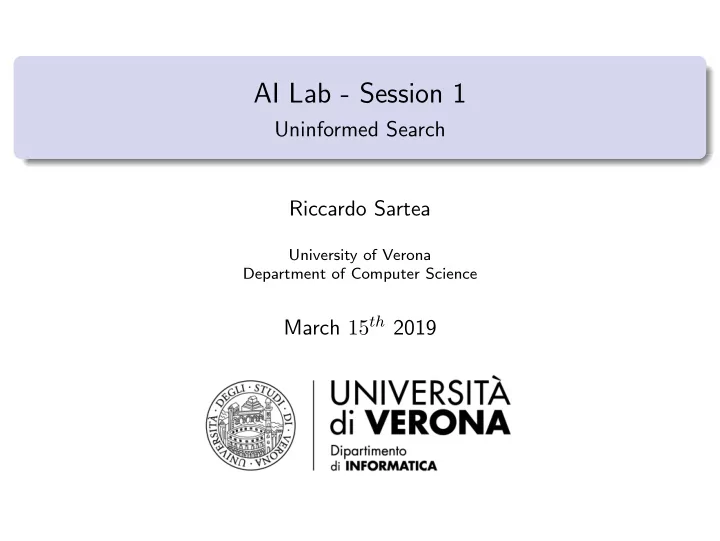

AI Lab - Session 1 Uninformed Search Riccardo Sartea University of Verona Department of Computer Science March 15 th 2019
The OpenAI Gym Framework What is it Gym is a toolkit for developing and comparing reinforcement learn- ing algorithms. It supports teaching agents everything from walk- ing to playing games like Pong or Pinball What is it for An open-source collection of environments that can be used for benchmarks A standardized set of tools to define and to work with environments Where to find it https://gym.openai.com AI Lab - Session 1 OpenAI Gym 2/8
Installation Process Install the Anaconda package manager for Python 3.7 from https://www.anaconda.com/distribution/ On linux use "sh Anaconda...version.sh" to install and add the bin folder to PATH when asked On linux reload bashrc with ”source ∼ /.bashrc” Use the following snippet of code to download an create the Python source code and environment Listing 1: Installation sudo apt-get install git (may be required) git clone https://github.com/SaricVr/ai-lab cd ai-lab conda env create -f ai-lab-environment.yml Then to start the environment and work on your assignments: Listing 2: Spin up conda activate ai-lab jupyter notebook The last command will open your browser for you to start working AI Lab - Session 1 Installation 3/8
Tutorial To open the tutorial navigate with your browser to: session1/session1 tutorial.ipynb AI Lab - Session 1 Tutorial 4/8
Assignments Your assignments for this session are at: session1/session1.ipynb AI Lab - Session 1 Tutorial 5/8
Algorithms In the following you can find pseudocode of the algorithms are required to implement in this session AI Lab - Session 1 6/8
Breadth-First Search (BFS) Input: problem Output: solution 1: node ← a node with State = problem. Initial-State 2: if problem. Goal-Test ( node. State ) then return Solution ( node ) 3: fringe ← Queue , with node as the only element 4: closed ← ∅ 5: loop 6: if Is-Empty ( fringe ) then return Failure 7: node ← Pop ( fringe ) ⊲ Remove node from frontier 8: closed ← closed ∪ node 9: for each action in problem. Actions ( node. State ) do child ← Child-Node ( problem, node, action ) 10: 11: if child. State not in fringe and child. State not in closed then 12: if problem. Goal-Test ( child. State ) then return Solution ( child ) 13: fringe ← Insert ( child, fringe ) Note: this is a graph search version AI Lab - Session 1 Uninformed Search 7/8
Iterative Deepening Search (IDS) 1: function Iterative-Deepening-Search ( problem ) 2: for depth ← 0 to ∞ do 3: result ← Depth-Limited-Search ( problem, depth ) 4: if result � = Cutoff then return result 5: function Depth-Limited-Search ( problem, limit ) 6: return Recursive-DLS ( Make-Node ( problem. Initial-State ) , problem, limit ) 7: function Recursive-DLS ( node, problem, limit ) 8: if problem. Goal-Test ( node. State ) then return Solution ( node ) 9: if limit = 0 then return Cutoff cutoff occurred ← False 10: 11: for each action in problem. Actions ( node. State ) do 12: child ← Child-Node ( problem, node, action ) 13: result ← Recursive-DLS ( child, problem, limit − 1) 14: if result = Cutoff then cutoff occurred ← True 15: else if result � = Failure then return result 16: if cutoff occurred then return Cutoff 17: return Failure Note: this is a tree search version AI Lab - Session 1 Uninformed Search 8/8
Recommend
More recommend